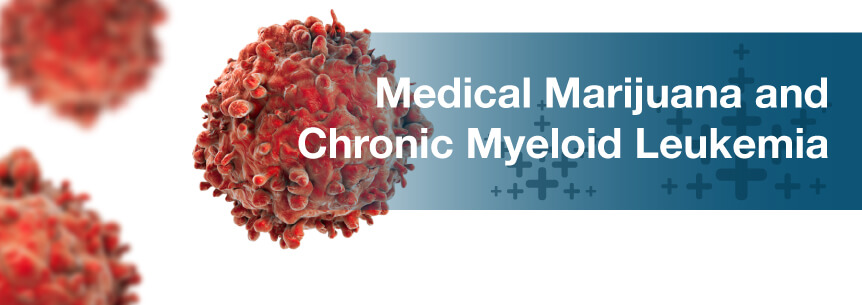
Cancer, though researched assiduously, is a problematic medical disease which still has a lot of unanswered questions regarding its cause, treatment and symptom management. However, lately, studies throughout the world are finding cannabis has therapeutic benefits for cancer patients, even medical marijuana for chronic myeloid leukemia. Let’s look at how it might help you with your symptoms.
Chronic myeloid leukemia, or CML for short, is a rare form of cancer involving your blood cells. It tends to develop and evolve gradually, as opposed to acute types of leukemia. Medical professionals and researchers also refer to this disease as chronic myelogenous leukemia, with “myelogenous” meaning the type of cells cancer affects.
Chronic myeloid leukemia tends to affect older adults, and while it can affect anyone at any age, it doesn’t typically affect children.
There are four primary leukemia types based on lymphocytic or myeloid and chronic or acute. These include:
In acute leukemias, the cells of your bone marrow don’t mature as they’re supposed to. They keep reproducing and building. If you don’t get treated, you may not live longer than a few months. Although treatment helps certain acute leukemia types and often cures patients, other types don’t have a good prognosis.
Lymphocytic leukemias begin in your lymphocytes. Lymphomas and lymphocytic leukemias are different, as lymphoma is usually located in lymph nodes and other tissues, while leukemia cancer is primarily in your blood and marrow.
Another chronic leukemia is chronic myelomonocytic leukemia, which affects your myeloid cells.

Literature first described CML in the 19th century. Until the 20th century, doctors managed CML primarily with chemotherapy and radiation. Later on, they began using recombinant Interferon-alfa and allogeneic stem cell transplantation.
Targeted therapy — which was developed due to the discoveries of the Philadelphia chromosome and BCR-ABL oncogene in 1960 and 1984, respectively — transformed the treatment of CML. The outcome and prognosis of CML patients improved significantly due to the use of imatinib treatment.
Chronic myeloid leukemia symptoms may include:
There aren’t always prominent signs of CML in its initial phase. You can live with the disease for years without knowing you have it. Since treatment works best when you start it in your early phases of CML, if you notice any continuous symptoms you’re concerned with, give your doctor a call right away.
There’s been a marked improvement in the outcome of CML patients. For instance, patients can now live with CML instead of dying from it. However, in some cases to improve your prognosis, you would require long-term treatment, which can have ill effects on your quality of life.
Although finishing the treatment may provide you with relief, it’s still difficult to not worry about a recurrence of the disease. Many people feel this way, and it often takes a long time before your fear goes away. Also, treatment itself has its uncertainties and can be stressful and troublesome.

You may have feelings of:
These feelings are natural when you’re dealing with cancer or any other debilitating disease.
According to the American Cancer Society, CML statistics for 2017 include:
Males are slightly more at risk than females to develop chronic myeloid leukemia, and the chance of getting it increases with age. While rare, a small number of individuals may develop CML after being exposed to a very high dosage of radiation, such as that caused by cancer therapy or a nuclear reactor event.
Doctors prescribe treatment for CML with the hopes of eliminating the abnormal BCR-ABL gene blood cells causing the plethora of diseased blood cells. But, while doctors may not be able to get rid of all the diseased cells, long-term remission is possible with treatment. Remission may not mean the cancer is gone, but it is less active. You can remain in remission from CML for many years.
Targeted drugs focus on a particular facet of cancer cells that enable them to grow and reproduce. In CML, the drugs attack the production of protein by the BCR-ABL gene. Drugs developed to block tyrosine kinase action include:
Most CML patients receive targeted drugs as their initial treatment. If they don’t have a response to the first targeted drug, oncologists will try omacetaxine and other types of targeted drugs.
Side effects of targeted drugs may include:
Physicians have not indicated what’s a safe time for chronic myeloid leukemia patients to stop taking their targeted drugs. Because of this, even if in remission of the disease, patients continue the medications.
The only clear-cut cure for CML is through a bone marrow transplant or blood stem cell transplant. Doctors usually perform this only in patients who aren’t responding to other treatments, since there can be severe complications with a blood stem cell transplant.
Physicians use high doses of chemotherapy during a blood stem cell transplant to kill cells forming blood in your bone marrow. Initially, doctors would obtain either your cells or a donor’s and store them. When it came time for this procedure, they would infuse them into your blood. Then, new healthy blood cells are formed by the new cells to replace the diseased cells.
Oncologists general use chemo drugs along with other CML treatments. In many cases, you take chemo treatment orally by the mouth as a tablet.
Side effects of chemotherapy drugs include:
Biological therapy uses your body’s immune system to fight cancer. Doctors may use interferon, a biological drug representing a synthetic version of immune system cells. This therapy helps decrease leukemia cell growth. Your medical team may consider this treatment when others haven’t worked, or if you’re unable to take other medications.
Side effects of interferon may include:
As studies of CML continue around the world both in clinical trials and laboratories, scientists and researchers continue to make ongoing progress in learning about how a person’s DNA changes result in normal bone marrow cells transforming into leukemia cells. Also, several vaccines and drugs are being investigated to use to attack CML.
CBD was found to prevent potential complications of a bone marrow or stem cell transplant in leukemia patients. Researchers found patients have a substantially lower risk of getting graft-versus-host disease, or GVHD, while they were using CBD treatment. GVHD occurs when transplanted cells attack your body.

Cannabis’ active components, cannabinoids, mimic endocannabinoids that activate specific cannabinoid receptors. They provide you with palliative effects and, in laboratory animals, have successfully inhibited the growth of tumors.
Marijuana for chronic myeloid leukemia can kill cancer cells in three distinct ways:
In the lab, marijuana and chronic myeloid leukemia prevented cells of tumors from building blood vessels. When you don’t have blood vessels, it starves the tumors.
Medical cannabis for chronic myeloid leukemia may treat symptoms of the disease by:
One of the best palliative effects cancer patients experience due to cannabinoids including stopping chemo-induced nausea and vomiting. These days, doctors approve and use THC capsules — dronabinol or Marinol and nabilone, its synthetic analogue, for this purpose.

Cancer patients also experience other palliative effects, such as pain inhibition and appetite stimulation, through cannabinoids. In fact, doctors prescribe dronabinol to combat excessive weight loss in CML patients.
Just about every state legalizing medical weed allows the use of the herb for patients with cancer or the symptoms related to the disease. This isn’t surprising, considering all the types of cancer and the related side effects of cancer treatments. Cannabis and chronic myeloid leukemia treatment can help with:
Below is a list of specific and potentially helpful strains for CML patients.
Medical cannabis works for nausea in patients, keeping them from vomiting, regardless if it’s due to CML or chemo. Some strains to try include:
Pain relief is among the most common uses of medical marijuana. Cancer patients face debilitating pain in some circumstances. Medical weed has THC and CBD in it, which both act as a natural pain reliever. They work together, providing you with outstanding pain relief.
Some strains to try include:
Cancer may result in a wasting illness if left untreated. Patients with cancer who are receiving certain treatments often lose their appetite. Medical pot helps increase your appetite and makes you want to eat. A couple of strains to try include:
To fight CML, you have to feel revitalized and well-rested. Medical marijuana for chronic myeloid leukemia provides you with the ingredients for a good night’s sleep. Try these strains:
Due to cancer’s nature, patients in many cases suffer from depression. They can experience intense mood swings as a treatment side effect. Medical cannabis helps boost your energy and mood and improves your outlook. Strains to try include:

Once you receive your recommendation and marijuana card, you can begin buying various types of medical weed from your local cannabis dispensary. But how will you use your treatment? Some methods may include:
Marijuana and chronic myeloid leukemia can treat a wide range of medical conditions, including cancer and its treatment side effects. You need to find a qualified doctor who will give you a recommendation to use the herb for your symptoms.
On our MarijuanaDoctors.com website, you can search for a medical marijuana doctor, pre-qualify, set up your appointment and more. It’s confidential, secure and meets HIPAA regulations. You can also find a cannabis dispensary. Professionals are standing by to help you find your best cannabis treatment for chronic myeloid leukemia symptom relief.
Find A Doctor Find A Dispensary